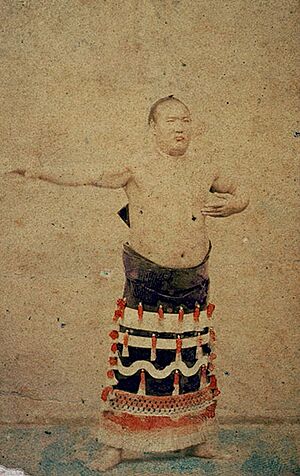Jinmaku Kyūgorō facts for kids
Quick facts for kids Jinmaku Kyūgorō |
|
|---|---|
| 陣幕 久五郎 | |

Script error: The function "getImageLegend" does not exist.
|
|
| Personal information | |
| Born | Ishigura Shintarō June 4, 1829 Itō, Izumo, Japan |
| Died | October 21, 1903 (aged 74) |
| Height | 1.74 m (5 ft 9 in) |
| Weight | 138 kg (304 lb) |
| Career | |
| Stable | Hidenoyama |
| Record | 87-5-65-17draws-3holds (Makuuchi) |
| Debut | November, 1850 |
| Highest rank | Yokozuna (July, 1867) |
| Retired | November, 1867 |
| Championships | 5 (Makuuchi, unofficial) |
| * Up to date as of June 2013. | |
Jinmaku Kyūgorō (陣幕 久五郎, June 4, 1829 – October 21, 1903) was a famous Japanese sumo wrestler. He came from a place called Itō in Izumo Province. He became the 12th yokozuna, which is the highest rank in sumo.
Contents
Jinmaku's Early Sumo Journey
Jinmaku was born in 1829 in what is now Matsue, Shimane Prefecture. His real name was Ishigura Shintarō (石倉 槇太郎). In 1847, he started learning sumo from a wrestler named Hatsushio Kyūgorō. This was in Onomichi, which is now part of Hiroshima Prefecture.
When Hatsushio passed away in 1848, Jinmaku moved to Osaka. There, he joined Asahiyama Shirouemon's sumo stable. He had his first official sumo match in 1850. At this time, he took on his first shikona, or ring name, which was Makinosuke Kuroodoshi (黒縅巻之助).
Moving to Edo and New Names
In 1850, Jinmaku traveled to Edo (which is now Tokyo). For a short time, he trained with Hidenoyama Raigorō, who was the 9th yokozuna. Jinmaku then began wrestling for the Tokushima Domain. This is when he took his most famous ring name, Jinmaku Kyūgorō (陣幕 久五郎).
He became known as one of the "Four Heavenly Kings of Awa". This group included other strong wrestlers like Kimenzan. Later, Jinmaku moved to wrestle for the Matsue Domain and then the Satsuma Domain. These changes led to some exciting rivalries with the wrestlers from the Tokushima domain.
Becoming a Yokozuna
Jinmaku was absent from four sumo tournaments between 1863 and 1865. He returned in November 1865 and became an ōzeki in November 1866. The ōzeki rank is just below yokozuna.
He received his yokozuna license in July 1867. However, the tournament in November 1867 was his last as an active wrestler. It is said that he left Edo to deliver important news to Saigō Takamori in Kyoto. During a time of big changes in Japan, called the Boshin War, Jinmaku stayed in Osaka to protect Shimazu Tadayoshi.
Jinmaku was a yokozuna for only one tournament. Despite this, he had an amazing record. He won 87 matches and lost only 5 in the top makuuchi division. All his losses happened before he became a yokozuna. He is the only wrestler to have never lost a match while holding the yokozuna title. His winning rate was an incredible 94.6%!
Life After Sumo
After retiring from active sumo, Jinmaku used his knowledge and connections to help the sport. He was appointed as a sumo supervisor in Osaka. He worked hard to make Osaka sumo stronger and more independent.
In 1873, he helped organize a special sumo event at the Osaka Mint Palace. He also helped promote two Osaka yokozuna. Jinmaku even managed his own sumo stable, a training group for wrestlers. However, Osaka sumo faced many challenges, and Jinmaku's influence slowly decreased. He officially retired in September 1890.
In 1901, he performed a special ring-entering ceremony at the Yasukuni Shrine. Jinmaku passed away in 1903.
The Yokozuna Monument Project
Jinmaku was very passionate about building monuments related to sumo. He spent a lot of his own money to create various monuments across Japan.
In 1900, he completed his biggest project: the Yokozuna Rikishi Memorial Monument. This monument is located at the Tomioka Hachiman Shrine in Tokyo. It was built to properly honor all the yokozuna who came before him. For the first time, Akashi Shiganosuke, Ayagawa Gorōji, and Maruyama Gondazaemon were officially recognized as the first three yokozuna thanks to Jinmaku's efforts.
See also
- Glossary of sumo terms
- List of past sumo wrestlers
- List of yokozuna


